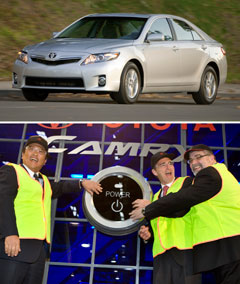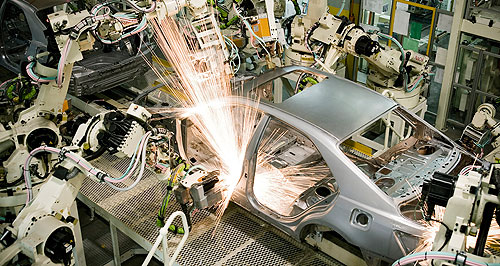Future models - Toyota - Camry - HybridToyota pushes button on Camry HybridSparks fly: A pilot-build Camry Hybrid starts its journey down the Toyota production line at Altona. Countdown to Toyota Camry Hybrid production – and decision on next generation for Oz31 Aug 2009 TOYOTA will make a decision on Australian production of the next generation of its ground-breaking fuel-saving Camry Hybrid next June, just five months after the locally produced first generation goes on sale in Australia in February. The tight deadline on the second-generation hybrid Camry – scheduled to arrive in late 2011 or early 2012 – was revealed by Toyota Australia today at a ceremony to mark the building of the first Camry Hybrid pilot vehicle at its Altona plant in Victoria. This first petrol-electric Camry Hybrid model – which Toyota says will achieve a 20 per cent fuel saving over the petrol-only Camry – is scheduled to go into full production in December for February delivery. The car is being introduced mid model cycle, and Toyota is already well down the track on the development of the new vehicle which Toyota Australia is confident will also get the nod for local production. Toyota Australia sales and marketing director David Buttner said talks were being held with Toyota in Japan right now about the next car.  Left: Toyota Camry. Below: Toyota Australia president and CEO Max Yasuda joins Victoran premier John Brumby and federal industry minister Kim Carr to start Camry Hybrid pilot production. Left: Toyota Camry. Below: Toyota Australia president and CEO Max Yasuda joins Victoran premier John Brumby and federal industry minister Kim Carr to start Camry Hybrid pilot production.“Those discussions are being made right now with Japan, on the vehicle, on the specifications to go in the next generation vehicle and we are confident that this vehicle would be successful and that the success of it (the Camry Hybrid to be introduced next year) will dictate and determine the next generation Camry Hybrid as well,” he said. He added that TMC had already displayed a great deal of confidence in the local ability to make a success of the Camry Hybrid by agreeing to “a lot of set up costs, a lot of training – there is a hell of a lot involved to make this plant ready”. “The final decision has to be made, but we remain quietly confident that we will make the next generation car, that this isn’t just a two-year wonder.” Toyota Australia revealed that that the first generation Camry Hybrid would achieve a fuel consumption figure of about 7 litres per 100km – 20 per cent less than the 8.8L/100km of the existing petrol-only Camry – when it goes on sale in February. Mr Buttner also laid a strong hint that the Camry Hybrid would carry a premium of less than $3500 over the equivalent petrol-only model. “We are deliberating on price,” he said. “We don’t want to frighten people away with a significant premium. “When you look at the diesel to petrol premium it is about $3000 to $3500 in most cases, and I think to go outside that wouldn’t really give us the best fertile ground to sell the product here in Australia.” Toyota hopes to sell at least 25 per cent of Camry Hybrids to private customers, and Mr Buttner used a speech at today’s event to pitch the new Camry as an economical alternative for families. “Every single family that travels 20,000km a year in a Hybrid Camry can expect to save hundreds of dollars on their average fuel bill,” he said. “Even compared with the most fuel-efficient large-six competitor, that family will save well over $10 a week, just on fuel.” Mr Buttner compared the Camry Hybrid to locally-produced six-cylinder family cars, a group that includes the Toyota Aurion which is also made at the Altona plant, to make a point about its fuel efficiency. “Last year, Australians bought just over 100,000 large, locally produced six-cylinder cars. If those motorists had bought a Toyota Camry instead, they could have saved $140 million on fuel alone,” he said. Toyota Australia has already been stripping and re-assembling Camry Hybrid models produced in Japan and the US at its Altona plant to work out what is required for the production process, and has made a series of alterations to the production line for the new model. It has now start producing a ‘couple of dozen’ pilot and prototype vehicles to hone the production process before customer cars start to roll down the line at the end of the year. The Camry Hybrid’s engine, electric motor and battery pack are all imported from Japan, as opposed to the regular Camry four-cylinder engine which is made at Altona. Mr Buttner said he hoped local suppliers eventually would be able to provide some of the hybrid components, but said production volume would need to be much higher than the initial 10,000 a year it expected of the Camry Hybrid. “Everything is based on the economy of scale. Once this vehicle establishes itself in Australia and we reach production volumes where you can reap those economies of scale there is no reason why, down the track, as we expand the hybrid range that there can’t be more supplier brought on board,” he said. Asked how many Camry hybrids Toyota would need to produce before it considered more local content, Mr Buttner said: “It would depend on a whole host of factors – the overall capacity of the plant, how many we are building in terms of naturally aspirated vehicles, what models we are building here, but you would have to get up into the vicinity of 35,000 to 40,000 vehicles I believe.” The Australian government announced last year that it had committed $35 million towards the Toyota Camry project, while the Victorian government has allocated an undisclosed sum. Federal industry minister Senator Kim Carr, who attended the ceremony along with Victorian premier John Brumby, was asked if this investment represented good value for money, given that hybrid components would be imported. “Value for money? It is huge value for tax-payers,” he said. “We are putting $35 million into this project, Toyota is putting in a lot more than that – a great deal more. “There are huge investments being made into the Australian automotive industry. There are benefits in terms of the taxes that are paid back to the Australian government, to the Victorian government, to the employment, to the research and development, to the exports “These are huge advantages to the Australian economy.” Asked if the government was happy the hybrid components would be imported, Senator Carr said: “You have got to start somewhere. “Bear in mind that this was a decision that Toyota had made to build these cars in Thailand. “Some of that production is now being moved to Australia. “Now what would you rather: that we import them? Because I don’t. I would prefer that the cars be made here and that we build up the localisation content as we improve the business case.”  Read moreAll future models Alfa Romeo Alfa Romeo Abarth Abarth Alpine Alpine Alpina Alpina Audi Audi Aston Martin Aston Martin BMW BMW Bentley Bentley Chery Chery Brabham Brabham Chrysler Chrysler Chevrolet Chevrolet Cupra Cupra Citroen Citroen DS DS Dodge Dodge Fiat Fiat Ferrari Ferrari Foton Foton Ford Ford Great Wall Great Wall FPV FPV Haval Haval GWM GWM Honda Honda Holden Holden Hummer Hummer HSV HSV Infiniti Infiniti Hyundai Hyundai Jaguar Jaguar Isuzu Isuzu Kia Kia Jeep Jeep Land Rover Land Rover Lamborghini Lamborghini Lexus Lexus LDV LDV Mahindra Mahindra Lotus Lotus Mazda Mazda Maserati Maserati Mercedes-AMG Mercedes-AMG McLaren McLaren MG MG Mercedes-Benz Mercedes-Benz Mitsubishi Mitsubishi Mini Mini Opel Opel Nissan Nissan Peugeot Peugeot Pagani Pagani Proton Proton Porsche Porsche Renault Renault Ram Ram Rover Rover Rolls-Royce Rolls-Royce Skoda Skoda Saab Saab SsangYong SsangYong Smart Smart Suzuki Suzuki Subaru Subaru Toyota Toyota Tesla Tesla Volvo VolvoCamry pricing
Motor industry news |
Click to shareToyota modelsResearch Toyota All future models Alfa Romeo Alfa Romeo Abarth Abarth Alpine Alpine Alpina Alpina Audi Audi Aston Martin Aston Martin BMW BMW Bentley Bentley Chery Chery Brabham Brabham Chrysler Chrysler Chevrolet Chevrolet Cupra Cupra Citroen Citroen DS DS Dodge Dodge Fiat Fiat Ferrari Ferrari Foton Foton Ford Ford Great Wall Great Wall FPV FPV Haval Haval GWM GWM Honda Honda Holden Holden Hummer Hummer HSV HSV Infiniti Infiniti Hyundai Hyundai Jaguar Jaguar Isuzu Isuzu Kia Kia Jeep Jeep Land Rover Land Rover Lamborghini Lamborghini Lexus Lexus LDV LDV Mahindra Mahindra Lotus Lotus Mazda Mazda Maserati Maserati Mercedes-AMG Mercedes-AMG McLaren McLaren MG MG Mercedes-Benz Mercedes-Benz Mitsubishi Mitsubishi Mini Mini Opel Opel Nissan Nissan Peugeot Peugeot Pagani Pagani Proton Proton Porsche Porsche Renault Renault Ram Ram Rover Rover Rolls-Royce Rolls-Royce Skoda Skoda Saab Saab SsangYong SsangYong Smart Smart Suzuki Suzuki Subaru Subaru Toyota Toyota Tesla Tesla Volvo VolvoCamry pricing
Motor industry news |















Facebook Twitter Instagram